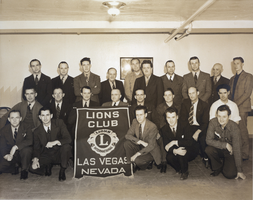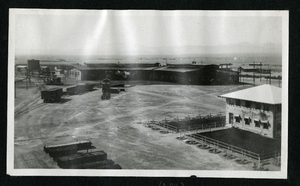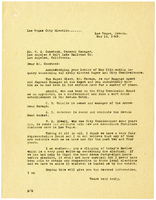Search the Special Collections and Archives Portal
Search Results

Photograph of Lions Club, Las Vegas, 1940
Date
Archival Collection
Description
Image

Photograph of the Las Vegas train yard and buildings, Las Vegas (Nev.), 1900-1925
Date
Archival Collection
Description
Image

Letter from an unknown author to W. H. Comstock, May 12, 1923
Date
Archival Collection
Description
Text
Mary Noblitt oral history interview
Identifier
Abstract
Oral history interview with Mary Noblitt conducted by Mary Sawdey on March 13, 1981 for the Ralph Roske Oral History Project on Early Las Vegas. Noblitt discusses moving to Las Vegas, Nevada and building housing in the southern part of town. Noblitt goes on to discuss communication through railroad and morse code. Lastly, Noblitt discusses the above ground atomic tests.
Archival Collection

Nanyu Tomiyasu interview, March 11, 1978: transcript
Date
Archival Collection
Description
On March 11, 1978, Sosuke Miyazawa interviewed Nanyu Tomiyasu (b. May 28, 1918 in Las Vegas, Nevada) about his family’s farm and their legacy as one of the pioneering families of the city. Tomiyasu begins by talking about what brought his family to Las Vegas, the city’s abundant water reservoir and his father’s farm. In particular, Tomiyasu discusses his father’s experiments with farming as one of the city’s early farmers, the transition into nursery farming and Japanese gardens. Moreover, he discusses his siblings, the local schools, their great quality, the successful students the city produced and the growth of school populations. Tomiyasu describes the large Japanese population and the Union Pacific Railroad that many of them worked on. He ends by discussing the change in architecture within the city, such as where old buildings stood and what they are used for now, the first Episcopal Church and the old Mormon Fort.
Text

Las Vegas Springs, Nevada
Date
Archival Collection
Description
Mixed Content

Transcript of interview with Hal G. Curtis by Bill Teepe, February 24, 1977
Date
Archival Collection
Description
On February 24, 1977, Bill Teepe interviewed Hal G. Curtis (born 1926 in Galt City, California) about his life in Southern Nevada. Curtis talks first about his work on the Union Pacific Railroad before discussing changes and development in Las Vegas, including development on the Strip and Downtown areas. He also talks about Block 16, the El Rancho Vegas fire, social clubs, and religion.
Text
